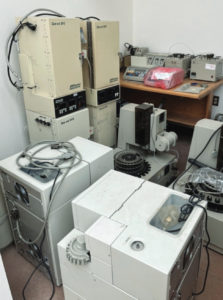Major Donation to Augment OAS Lab Work

Super Critical Fluids equipment will help further non-destructive analysis at the Office of Archaeological Studies
Written by Shelby Jones, OAS
One of the challenges and fun opportunities for creativity in radiocarbon dating is pretreating specimens in order to remove any contamination.
In the OAS Low Energy Plasma Radiocarbon Sampling Laboratory, almost all specimens undergo some pre-treatment but this step is especially important for buried artifacts that must be subjected to the removal of contaminating organic materials that permeate through the soil and into the artifacts. If not removed, these materials can cause serious errors in dating through the introduction of carbon that may be a different age than the artifact (i.e., contamination).
In radiocarbon pre-treatment, performed by other radiocarbon laboratories around the world, but not at the OAS, an artifact/sample is washed with 120° F strong base. As a result of this harsh pre-treatment, the artifact may partially dissolve or become altered; this is not ideal. Due to the low temperature characteristics of the OAS plasma sampling technique, the standard OAS pre-treatment procedure does not need to be so harsh, allowing for a near non-destructive procedure to be used instead.
Neither method is guaranteed to remove all contamination. Non-destructive sampling is definitely preferred, so the creative search for new pre-treatment methods continues.
In 2004, Marvin Rowe, lead scientist and volunteer in the OAS radiocarbon laboratory, suggested using super critical fluids (SCFs) as a nondestructive means of removing contamination and organic matter. Known to be very good solvents of organic materials, SCFs are gases that behave like liquids due to the temperature and pressure conditions that they experience. For example, carbon dioxide gas becomes a SCF when it is subjected to slightly elevated temperatures (~40° C, a hot day in Phoenix) and very high pressure (100 to 1,000 times earth’s atmospheric pressure).
To learn about SCFs, Marvin arranged a six-month sabbatical at Los Alamos National Laboratory (LANL) with Kirk Hollis and Dr. Jerry King. Due to unforeseen events, the sabbatical was shortened to just two days of observing. Luckily, the abbreviated sabbatical blossomed into a successful collaboration between Marvin and Jerry, who later took a job as a professor of chemical engineering at the University of Arkansas. Together, Marvin and Jerry demonstrated that using SCFs as a pre-treatment was indeed a promising technique for removing contamination from numerous materials, including seeds and textiles.
Jerry recently retired from the University of Arkansas and was looking for a new home for his SCF systems. Remembering his collaboration with Marvin, Jerry approached OAS and we excitedly accepted his offer.
In June, Marvin, OAS employee Jeff Cox, and OAS volunteer John Martin met with Jerry in Fayetteville, Arkansas, selecting about 2 tons of donated equipment for the trip back to Santa Fe. The most important pieces were four SCFs units, valued at tens of thousands of dollars. These newly acquired SCFs units will augment the non-destructive analysis protocols used by the OAS Radiocarbon Sampling Laboratory, much improving the lab's performance. Stay tuned while the laboratory staff works to overhaul the lab to accommodate this new equipment and put it to good use.
OAS and FOA are gratified by the response to recent pleas for financial support for our research programs. Several generous contributions have exceeded our hopes for the research campaign. Since OAS does not receive State funds for education, and if you intend to give but haven’t yet, please consider directing your contribution to education. For information, contact Lauren Paige at lauren@museumfoundation.org.
This article and image is from the Friends of Archaeology Newsletter, August 2022.


Connect